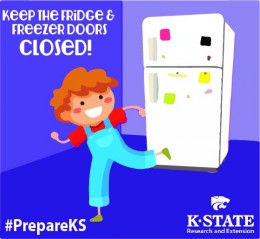September is National Preparedness Month. It is also the month of the K-State Research and Extension annual Prepare Kansas online challenge. Prepare Kansas 2016 focuses on keeping food safe in emergency situations. This year’s program will be conducted through the K-State Research and Extension Facebook page. No registration is required, so Kansans and anyone interested in planning ahead for emergencies can follow on Facebook and this blog at any time during September, pick up handy information and interact with K-State extension specialists and agents.
As tempting as it might be to check the temperature inside your refrigerator and freezer when the power goes out, the best thing to do is to keep the doors closed.
the best thing to do is to keep the doors closed.
A refrigerator will keep food cold for about 4 hours if the door is kept closed. A full freezer will hold its temperature for about 48 hours (24 hours if half-full). If you anticipate the power will be out for longer than that, prepare to use ice and coolers to keep your food safe.
Prepare ahead of a storm by following these USDA Food Safety Tips:
- Freeze water in one-quart plastic storage bags or small containers prior to a storm. These containers are small enough to fit in around the food in the refrigerator and freezer to help keep food cold. Remember, water expands when it freezes so don’t overfill the containers.
- Freeze refrigerated items, such as leftovers, milk and fresh meat and poultry that you may not need immediately—this helps keep them at a safe temperature longer.
- Know where you can get dry ice or block ice.
- Have coolers on hand to keep refrigerator food cold if the power will be out for more than four hours.
Click on the graphic above for more information about food safety information during severe storms from the USDA.


